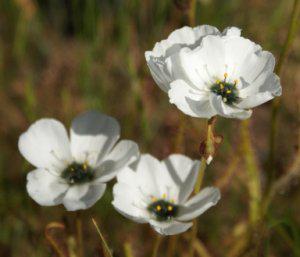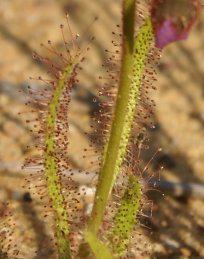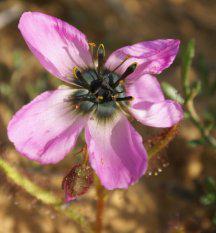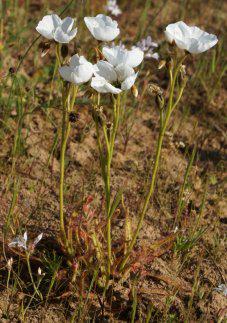Drosera cistiflora
Drosera cistiflora L.
Family: Droseraceae
Common names: poppy-flowered sundew (Eng.);doublom, snotrosie (Afr.)
Introduction
The magnificent flower, colour and variety of Drosera cistiflora will captivate any carnivorous plant enthusiast.

Description
Description
Drosera cistiflora is a perennial carnivorous plant. Elongated, spear-shaped leaves (20-40 mm x 4mm) which taper from top to bottom are scattered along the stem, usually alternately. Some plants form a primary basal rosette which has more narrowly elongated oval leaves. Plants are variable in growth forms and some do not have a noticeable basal rosette. The erect stems are unbranched and 100 to 400 mm high. Leaves are sessile and the stipules are hardly noteworthy or absent. Both types of tentacles occur near the base of the leaves. Mostly large elongated reddish knob-shaped tentacles are present on the upper leaf margin and tip.

The plants have one or two long, swollen roots which are covered with densely matted root hairs. A single or a few large white, yellow, mauve, pink or purple to dark red flowers are borne from August to September. Styles are fringed. Brown seeds are oval to ellipsoid and honey-combed. The seed capsule is top-shaped (turbinate).

Conservation Status
Status
This species is not threatened.
Distribution and habitat
Distribution description
Drosera cistiflora is common in the Cape winter-rainfall regions, occurring from Namaqualand in the Northern Cape to Port Elizabeth in the Eastern Cape. The red flowering form is from the Malmesbury District. The species occurs at altitudes of 20-1250 m on well-drained, moist, sandy soils on hills, slopes or flats in fynbos areas and in open clearings or post-fire when vegetation is low.
Derivation of name and historical aspects
History
Drosera gets its name from the Greek word, droseros, meaning dewy and alludes to the sticky dew-like excretions on the leaves. The species gets its name from the flowers' resemblance to another plant, Cistus, commonly known as the rock rose. The name Cistus is derived from the Greek kistos which was the original name used to describe the rock rose in ancient Greece.

Synonyms include Drosera helianthemum, D. pauciflora var. minor, D. speciosa and D. zeyheri.
Drosera cistiflora, along with Drosera capensis, were the first two Cape Drosera species to be recorded and illustrated and can be found in Burman's book, Rariorum Africanarum Plantarum.
Ecology
Ecology
Flowers are open very briefly for a few hours with good sunlight. The flowers can be pollinated by insects, but are usually self-pollinated. When the seeds are ripe, their capsules open to release the fine, light-weight seeds which fall out and are dispersed near the parent plants.
Probably the most interesting characteristic of this plant is its ability to digest the nutrients, especially the nitrogen it requires from insects caught in its stalked tentacles. Different types of glandular growths include marginal tentacles situated near the lamina margins, discal tentacles which are shorter and disc-like, usually on the upper leaf surfaces, digestive glands filled with red fluid and glandular hair-like growths on the inflorescence. The tentacles are sensitive and mobile. Their stalks end in a bulbous head in which the glandular cells occur. These glands secret a glistening, sticky, clear fluid used to trap and retain prey. There is speculation that the fluid is slightly sweetly scented to attract insects. The fluid contains a weak acid and enzymes that digest the soft parts of the prey. The sensitive tentacles are able to detect caught prey and to produce more dew to entrap their victim. Neighbouring tentacles then mobilize and slowly lean over to engulf the hapless victim. The lamina itself may also fold over to enclose or suffocate larger prey and allow for better absorption. As sensitive as these tentacles are, they are able to distinguish between a meal and other stimuli, for example, the leaf and tentacles do not respond to water droplets.
Uses
Use
Droseras make fascinating house and conservatory plants around the world.They are better suited to being grown outdoors. But grow them under roof, in South Africa, if you wish to retain their vivid red colouration . Plants can be brought indoors for short periods for display. Drosera cistiflora is a delicate species to grow, not long-lived in containers and not necessarily the easiest for novices.

Drosera has also been recorded for use against various ailments. Extracts of the leaves were used externally for warts, corns and sunburn. Disorders such as tuberculosis, asthma, coughs, eye and ear infection, liver pain, morning sickness, stomach conditions, syphilis, toothache and intestinal problems were treated internally with teas or extracts made from the leaves. The tea was also used as a tranquilizer, and some believe that it has aphrodisiac properties. Anti-spasmodic agents have been found by scientists in some Drosera species
Growing Drosera cistiflora
Grow
A very well drained sandy soil is the best growth medium, 2 parts sand or silica grit: 1 part peat or sphagnum moss, in 9-15 cm pots are ideal. It is important not to over-pot plants. Taller rather than wider pots are ideal for Drosera to thrive and to accommodate their few, but long roots. Place the potted plants in a shallow saucer filled with fresh water to keep them moist at all times during their growth season. The author has had the best success growing this species out of saucers, but watering every other day. Drosera cistiflora roots are prone to rotting if they are water-logged. If using the saucer method, allow the saucer to dry out occasionally so that the medium can aerate. This will not harm your plants so long as the moisture content in the medium is still high.
Place in a northern or eastern direction for best sunlight if growing indoors. Grow in full sun to light shade outdoors. During the dormant period in summer, remove pots from water trays, but do not allow soil to dry completely. The author allows for very minimal, light watering over the dormant phase. This technique has successfully kept plants alive over their dormant period and allowed mature plants to resprout the following winter. Other growers recommend removing roots and tubers and keeping them in a sealed container in a cool environment.
Sundews are easily propagated by seed. Prepare a 90 mm pot with growth medium; water well. In autumn sow fresh seeds on the surface in moist growth medium. Do not cover with growth medium. Place in a semishady position, and seeds should germinate in 2-4 weeks.
Ironically, the carnivorous plants are attacked by insect pests. Aphids, mealy bug and thrips cause deformity in new growth. Treat with a diluted pesticide or remove pests by hand. Never use a soap-based insecticide. Drying out can cause drooping and the decrease in mucilage production. Watering and keeping the plant moist will revive them. Dew production may stop after transplanting or if the leaf comes into contact with inquisitive hands. New foliage will, however, grow and continue to produce dew.
References
- Codd, L.E, De Winter, B. & Killick, D.J.B. 1970. Flora of Southern Africa 13. National Botanic Gardens Kirstenbosch, Cape Town.
- Goldblatt, P. & Manning, J.C. 2000. Cape plants. A conspectus of the Cape flora of South Africa. Strelitzia 9. National Botanical Institute, Pretoria.
- Smith, C.A. 1966. Common names of South African plants. Memoirs of the Botanical Survey of South Africa No. 35.
- Stearn, W.T. 2002. Stearn's dictionary of plant names for gardeners. Timber Press, Oregon.
- Trinder Smith, T. (text), Maytham Kidd, M. & Anderson, F. (illustration). 2006. Wild flowers of the Table Mountain National Park . Botanical Society of South Africa, Cape Town.
Credits
Monique McQuillan
Kirstenbosch National Botanical Garden
October 2012
Plant Attributes:
Plant Type: Perennial
SA Distribution: Eastern Cape, Western Cape
Soil type: Sandy
Flowering season: Spring, Early Summer
PH: Acid
Flower colour: Red, White, Pink
Aspect: Full Sun
Gardening skill: Challenging
Special Features:
Horticultural zones









Rate this article
Article well written and informative
Rate this plant
Is this an interesting plant?
Login to add your Comment
Back to topNot registered yet? Click here to register.